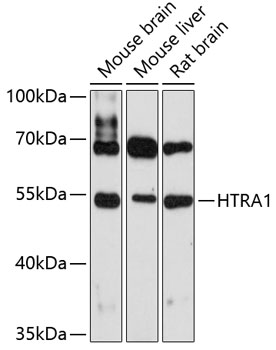Cell Biology Antibodies 2
Anti-HTRA1 Antibody (CAB11693)
- SKU:
- CAB11693
- Product Type:
- Antibody
- Reactivity:
- Mouse
- Reactivity:
- Rat
- Host Species:
- Rabbit
- Isotype:
- IgG
- Antibody Type:
- Polyclonal Antibody
- Research Area:
- Cell Biology
Description
| Antibody Name: | Anti-HTRA1 Antibody |
| Antibody SKU: | CAB11693 |
| Antibody Size: | 20uL, 50uL, 100uL |
| Application: | WB |
| Reactivity: | Mouse, Rat |
| Host Species: | Rabbit |
| Immunogen: | Recombinant fusion protein containing a sequence corresponding to amino acids 22-160 of human HTRA1 (NP_002766.1). |
| Application: | WB |
| Recommended Dilution: | WB 1:500 - 1:2000 |
| Reactivity: | Mouse, Rat |
| Positive Samples: | Mouse brain, Mouse liver, Rat brain |
| Immunogen: | Recombinant fusion protein containing a sequence corresponding to amino acids 22-160 of human HTRA1 (NP_002766.1). |
| Purification Method: | Affinity purification |
| Storage Buffer: | Store at -20'C. Avoid freeze / thaw cycles. Buffer: PBS with 0.02% sodium azide, 50% glycerol, pH7.3. |
| Isotype: | IgG |
| Sequence: | AQLS RAGR SAPL AAGC PDRC EPAR CPPQ PEHC EGGR ARDA CGCC EVCG APEG AACG LQEG PCGE GLQC VVPF GVPA SATV RRRA QAGL CVCA SSEP VCGS DANT YANL CQLR AASR RSER LHRP PVIV LQRG ACGQ GQE |
| Gene ID: | 5654 |
| Uniprot: | Q92743 |
| Cellular Location: | Cytoplasm, Secreted, cytosol |
| Calculated MW: | 51kDa |
| Observed MW: | 51kDa |
| Synonyms: | HTRA1, ARMD7, CADASIL2, CARASIL, HtrA, L56, ORF480, PRSS11 |
| Background: | This gene encodes a member of the trypsin family of serine proteases. This protein is a secreted enzyme that is proposed to regulate the availability of insulin-like growth factors (IGFs) by cleaving IGF-binding proteins. It has also been suggested to be a regulator of cell growth. Variations in the promoter region of this gene are the cause of susceptibility to age-related macular degeneration type 7. |
| UniProt Protein Function: | HTRA1: Serine protease with a variety of targets, including extracellular matrix proteins such as fibronectin. HTRA1-generated fibronectin fragments further induce synovial cells to up-regulate MMP1 and MMP3 production. May also degrade proteoglycans, such as aggrecan, decorin and fibromodulin. Through cleavage of proteoglycans, may release soluble FGF-glycosaminoglycan complexes that promote the range and intensity of FGF signals in the extracellular space. Regulates the availability of insulin-like growth factors (IGFs) by cleaving IGF-binding proteins. Inhibits signaling mediated by TGF-beta family members. This activity requires the integrity of the catalytic site, although it is unclear whether TGF-beta proteins are themselves degraded. By acting on TGF-beta signaling, may regulate many physiological processes, including retinal angiogenesis and neuronal survival and maturation during development. Intracellularly, degrades TSC2, leading to the activation of TSC2 downstream targets. Variations in the promoter region of HTRA1 are the cause of susceptibility to age-related macular degeneration type 7 (ARMD7). ARMD is the leading cause of vision loss and blindness among older individuals in the developed word. It is classified as either dry (nonneovascular) or wet (neovascular). ARMD7 is a wet form, in which new blood vessels form and break beneath the retina. This leakage causes permanent damage to surrounding retinal tissue, distorting and destroying central vision. Wet ARMD is more prevalent among Asians than Caucasians. Defects in HTRA1 are the cause of cerebral autosomal recessive arteriopathy with subcortical infarcts and leukoencephalopathy (CARASIL). CARASIL is characterized by nonhypertensive cerebral small-vessel arteriopathy with subcortical infarcts, alopecia, and spondylosis, with an onset in early adulthood. On neuropathological examination, atherosclerosis associated with intimal thickening and dense collagen fibers, loss of vascular smooth-muscle cells, and hyaline degeneration of the tunica media has been observed in cerebral small arteries. Belongs to the peptidase S1B family. |
| UniProt Protein Details: | Protein type:EC 3.4.21.-; Secreted, signal peptide; Secreted; Protease Chromosomal Location of Human Ortholog: 10q26.3 Cellular Component: extracellular matrix; extracellular space; cytosol Molecular Function:insulin-like growth factor binding; serine-type peptidase activity; serine-type endopeptidase activity Biological Process: negative regulation of defense response to virus; regulation of cell growth; negative regulation of transforming growth factor beta receptor signaling pathway; proteolysis; positive regulation of epithelial cell proliferation; negative regulation of BMP signaling pathway Disease: Macular Degeneration, Age-related, 7; Cerebral Autosomal Recessive Arteriopathy With Subcortical Infarcts And Leukoencephalopathy |
| NCBI Summary: | This gene encodes a member of the trypsin family of serine proteases. This protein is a secreted enzyme that is proposed to regulate the availability of insulin-like growth factors (IGFs) by cleaving IGF-binding proteins. It has also been suggested to be a regulator of cell growth. Variations in the promoter region of this gene are the cause of susceptibility to age-related macular degeneration type 7. [provided by RefSeq, Jul 2008] |
| UniProt Code: | Q92743 |
| NCBI GenInfo Identifier: | 18202620 |
| NCBI Gene ID: | 5654 |
| NCBI Accession: | Q92743.1 |
| UniProt Secondary Accession: | Q92743,Q9UNS5, D3DRE4, |
| UniProt Related Accession: | Q92743 |
| Molecular Weight: | |
| NCBI Full Name: | Serine protease HTRA1 |
| NCBI Synonym Full Names: | HtrA serine peptidase 1 |
| NCBI Official Symbol: | HTRA1 |
| NCBI Official Synonym Symbols: | L56; HtrA; ARMD7; ORF480; PRSS11; CARASIL |
| NCBI Protein Information: | serine protease HTRA1; IGFBP5-protease; protease, serine, 11 (IGF binding); high-temperature requirement A serine peptidase 1 |
| UniProt Protein Name: | Serine protease HTRA1 |
| UniProt Synonym Protein Names: | High-temperature requirement A serine peptidase 1; L56; Serine protease 11 |
| Protein Family: | Serine protease |
| UniProt Gene Name: | HTRA1 |
| UniProt Entry Name: | HTRA1_HUMAN |
View AllClose







